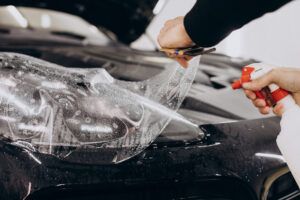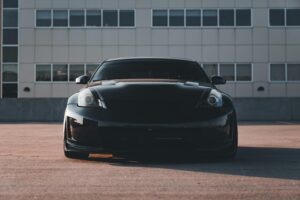The scorching Utah sun beats down relentlessly on Salt Lake City streets. Winter brings road salt that eats away at your car’s finish. Spring canyon drives kick up rocks and debris. Your vehicle faces constant assault from the elements, and smart car owners know that protecting their investment requires more than just regular washing.
Walk through any upscale neighborhood in Draper or Park City, and you’ll notice something interesting about the luxury vehicles parked in driveways. They gleam with an almost liquid shine that seems impossible to achieve with traditional waxing. These car enthusiasts have discovered what professional detailers have known for years: the powerful combination of paint correction and ceramic coating creates an unbeatable shield against environmental damage.
Understanding the Foundation: What Paint Correction Really Does
Before you can build wealth, you need to eliminate debt. The same principle applies to your car’s finish. Paint correction service SLC specialists understand that ceramic coating applied over damaged paint is like putting expensive wallpaper over cracked walls. The underlying problems remain, waiting to worsen over time.
Paint correction involves methodically removing surface imperfections through specialized polishing techniques. Think of it as resurfacing rather than covering up. Swirl marks from improper washing disappear. Light scratches vanish. Oxidation gets stripped away. The process reveals the pure, unblemished paint underneath, creating the perfect canvas for protection.
Professional detailers use various grades of polishing compounds and specialized tools to achieve different levels of correction. Light correction might remove 50-60% of imperfections, while intensive correction can eliminate up to 95% of surface flaws. The level needed depends on your vehicle’s current condition and your expectations for the final result.
The Science Behind Ceramic Coating Protection
Once paint correction creates that flawless foundation, ceramic coating acts as an invisible armor. This liquid polymer chemically bonds with your vehicle’s paint at the molecular level, creating a protective layer that’s measured in nanometers yet provides years of defense.
Unlike traditional wax that sits on top of paint and washes away within weeks, ceramic coating becomes part of the paint structure itself. The coating fills in microscopic pores in the clear coat, creating an incredibly smooth surface that repels water, dirt, and contaminants.
The hydrophobic properties mean water beads up and rolls off, taking dirt and grime with it. UV rays that would normally fade and oxidize paint get reflected away. Chemical contaminants like bird droppings and tree sap can’t penetrate the coating’s barrier, making them easy to remove before they cause permanent damage.
Why the Combination Works Better Than Either Service Alone
Applying ceramic coating without paint correction is like wearing an expensive suit over dirty clothes. You might look good from a distance, but up close, the flaws remain visible. The coating will lock in swirl marks, scratches, and contamination, preserving them under a glossy shell.
Conversely, paint correction without ceramic coating leaves your newly perfected finish vulnerable. Within weeks, normal driving and washing will introduce new swirl marks. Environmental contaminants will begin etching into the unprotected clear coat. Your investment in paint correction starts degrading immediately.
The combination creates a synergy where each service enhances the other. Paint correction provides the perfect surface for ceramic coating to bond properly, ensuring maximum durability and appearance. The ceramic coating then preserves that corrected finish, maintaining the showroom shine for years instead of weeks.
Research from the International Detailing Association shows that vehicles receiving both services maintain 85% of their corrected finish quality after three years, compared to just 20% for vehicles receiving paint correction alone.
The Salt Lake City Factor: Why Local Conditions Demand Extra Protection
Salt Lake City’s unique geography creates particularly challenging conditions for automotive finishes. The combination of high altitude UV exposure, winter road salt, and desert dust creates a perfect storm of paint-damaging elements.
During winter months, UDOT applies nearly 300,000 tons of road salt throughout the region. This salt doesn’t just sit on roads – it becomes airborne, coating vehicles in a corrosive mist. Spring runoff carries mineral deposits from the surrounding mountains, leaving water spots that can etch into unprotected paint.
Summer temperatures regularly exceed 100°F, causing paint to expand and contract. This thermal cycling accelerates the breakdown of traditional protection methods. Add in the occasional hailstorm and frequent construction dust from the valley’s rapid growth, and it becomes clear why standard protection falls short.
Professional detailers in areas like Sandy and Cottonwood Heights report seeing significantly more paint damage on unprotected vehicles compared to similar climates at lower elevations. The intense UV radiation at 4,300 feet elevation breaks down clear coat 40% faster than at sea level, according to automotive paint manufacturer PPG Industries.
The Investment Perspective: Long-Term Value Protection
Consider your vehicle like any other asset in your portfolio. Depreciation is inevitable, but smart maintenance strategies can minimize the loss. A well-maintained vehicle with pristine paint can command 15-20% more at resale than one with visible wear and damage.
The cost of professional paint correction and ceramic coating typically ranges from $800 to $3,000, depending on vehicle size and condition. This investment pays dividends through reduced maintenance costs, preserved resale value, and the intangible benefit of driving a vehicle that looks spectacular every day.
Calculate the true cost of ownership without protection: monthly car washes at $30, quarterly waxing at $150, annual paint touch-ups at $500, plus the inevitable full repaint at $3,000-5,000 after several years. The numbers favor preventive protection.
The Professional Process: What to Expect
Quality shops follow a meticulous process that ensures optimal results. The journey begins with a thorough assessment of your paint’s current condition. Technicians use specialized lighting and paint depth gauges to identify imperfections invisible to the untrained eye.
Decontamination comes next. Clay bar treatment removes embedded contaminants. Iron removers dissolve metallic particles. Multiple washing stages ensure absolutely clean paint. This preparation phase often takes longer than the actual correction process.
Paint correction involves multiple stages using different compounds and pads. Technicians constantly monitor their progress, ensuring they remove imperfections without unnecessarily thinning the clear coat. Modern paint thickness gauges help maintain safe levels throughout the process.
After achieving the desired correction level, intensive surface preparation ensures optimal coating adhesion. The ceramic coating application requires controlled environmental conditions – temperature, humidity, and dust levels must fall within specific ranges. Professional shops use climate-controlled bays to guarantee these conditions.
The coating application itself demands precision. Too much product wastes money and can cause high spots. Too little compromises protection. Experienced technicians understand the exact amount needed for each panel, working methodically to ensure complete, even coverage.
Maintenance After Protection: Preserving Your Investment
Your financial education doesn’t end after making an investment – monitoring and maintenance ensure continued returns. Similarly, paint protection requires proper care to deliver promised longevity.
Washing techniques matter more than frequency. Two-bucket methods prevent reintroducing contaminants. pH-neutral soaps preserve the coating’s integrity. Proper drying techniques prevent water spots. These simple adjustments to your routine make the difference between protection lasting two years or five.
Annual inspections by your detailing professional can identify areas needing attention before problems develop. Minor touch-ups to the coating cost far less than complete reapplication. Think of it as rebalancing your investment portfolio – small adjustments maintain optimal performance.
Some shops offer maintenance programs that include periodic decontamination washes and coating boosters. These services help maximize the lifespan of your protection while maintaining that just-detailed appearance.
Choosing the Right Professional in Salt Lake City
Not all detailing services deliver equal results. The difference between adequate and exceptional lies in experience, equipment, and attention to detail. Research potential shops thoroughly. Look for certifications from coating manufacturers. Review their portfolio of completed work.
Ask specific questions about their process. How many stages of paint correction do they offer? What type of lighting do they use for inspection? How do they measure paint thickness? Do they offer warranties on their work? The answers reveal their level of professionalism.
Location matters too. Shops in climate-controlled facilities produce more consistent results than mobile detailers working in driveways. The controlled environment prevents contamination during application and ensures proper curing conditions.
Making the Decision: Is Combined Protection Right for You?
Every financial decision requires evaluating your specific situation and goals. The same applies to paint protection. Consider how long you plan to keep your vehicle. Evaluate your tolerance for imperfections. Calculate the value of time saved on maintenance.
For many Salt Lake City drivers, the combination of paint correction and ceramic coating represents smart asset protection. The harsh local environment accelerates paint degradation, making professional protection more valuable than in milder climates. Whether you’re preserving a luxury vehicle in Park City or protecting your daily driver through Wasatch winters, the investment often proves worthwhile.
The transformation goes beyond mere appearance. There’s satisfaction in maintaining your property at its peak condition. Pride in ownership translates to better overall vehicle care. The psychological benefit of driving a pristine vehicle adds value beyond monetary calculations.
Your vehicle represents one of your largest purchases. Protecting that investment through professional paint correction and ceramic coating isn’t just about vanity – it’s about intelligent asset management. The combination provides maximum protection against Salt Lake City’s challenging conditions while preserving your vehicle’s value and appearance for years to come.
Frequently Asked Questions
How long does ceramic coating last after paint correction?
Professional-grade ceramic coatings typically last 3-5 years when properly maintained. Some premium formulations can extend protection up to 7 years. The paint correction underneath remains preserved throughout this period, maintaining that showroom finish far longer than traditional protection methods.
Can I apply ceramic coating myself after professional paint correction?
While DIY ceramic coating products exist, professional application ensures optimal results. Consumer-grade coatings typically last 6-12 months compared to professional formulations lasting several years. Additionally, improper application can result in high spots or streaking that require professional correction to fix.
How soon after paint correction should ceramic coating be applied?
Ideally, ceramic coating should be applied immediately after paint correction, typically within 24-48 hours. This ensures the corrected surface remains contamination-free and provides optimal bonding conditions. Most professional shops complete both services in the same appointment.
Will ceramic coating prevent rock chips and door dings?
Ceramic coating provides excellent protection against chemical damage, UV rays, and minor scratches, but it’s only a few nanometers thick. It cannot prevent impact damage from rocks or door dings. For that level of protection, consider paint protection film (PPF) in high-impact areas.
How much does paint correction and ceramic coating cost in Salt Lake City?
Pricing varies based on vehicle size, paint condition, and protection level chosen. Basic packages for sedans start around $800-1,200. SUVs and trucks typically range from $1,200-2,000. Luxury vehicles or those requiring extensive correction can reach $2,500-3,500. Premium coating packages with longer warranties command higher prices but offer superior protection.



